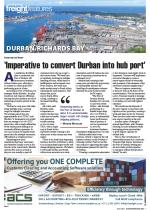An ambitious $7-billion plan to modernise the Port of Durban will future-proof southern Africa’s busiest port, allowing it to reclaim its status as the best-performing port in Africa. According to Port of Durban port manager Moshe Motlohi, the plan would not only improve efficiency, but help the port perform its role of anchoring economic growth in the country. “Durban is a way port with ships doing multiple stops, carrying cargo for multiple customers. The average parcel sizes are approximately 4000 TEUs,” said Motlohi. “A destination port would have an average of 15 000-TEU parcel size, with a single off loading of the entire parcel making it an extremely efficient operation. In our case, because we handle small parcel sizes for multiple customers, off loading is a complex process.”Explaining how most manufacturing boxes were heavy and therefore usually stored at the bottom of the vessel hatch, Motlohi said the first task on arrival at the port was usually to peel off containers from the top to get to the bottom boxes. “We then have to backload, resulting in multiple handling of boxes, which leads to inefficiencies and increased costs. From Durban, the vessel may make another stop in South Africa, repeating the same sequence. This means that a port stay in South Africa is long, resulting in increased handling costs. ”All of this, said Motlohi, made it imperative to convert Durban into a hub port to handle new-generation vessels carrying 15 000 or more TEUs, with a single stop in South Africa and feeder vessels running to the other ports in the country and even region.“There is no doubt that deepening berths at the Port of Durban to allow it to accommodate larger vessels will change shipping patterns. We believe it will make Durban and South Africa more attractive as a trade destination and will reduce the unit cost of exporting containers by an estimated 30%.”Motlohi said creating a hub-status port provided the opportunity to substantially increase the handling of transhipment volumes destined for ports in the broader SADC region.“The Port of Durban already handles 60% of trade to and from South Africa – and through positioning it to handle larger ships of 15 000 TEUs or more, at substantially better performance than at present, it can be repositioned to serve the dominant Southern Hemisphere shipping lanes,” he said.Motlohi added that it was, however, critical to improve the rail logistics solution on the Durban to Gauteng corridor (NatCor) as this was critical to supporting the major developments planned for the Port of Durban. “Creating a competitive alternative to the dominant road supply chain is imperative. Transnet will implement structural changes to create a mixed-equity model of ownership and operation of the elements of the rail-based container supply chain.”Plans to improve connectivity to the port were at the heart of the transformation. “For the automotive sector, Transnet intends to leverage private sector capital and capabilities to revitalise port and rail logistics solutions.”This would see the disposal of the auto wagons to customers and logistics service providers, creating a hook-and-haul service by Transnet. Plans are also under way to expand auto export capacity at the port.Another aspect of change is around liquid fuels, with Transnet focusing on asset utilisation while leveraging private partnerships to grow import capacity for refined fuels.“Key to this revitalisation of underutilised assets is to create the Transnet Fuel Import Terminal at the Port of Durban, feeding into the new multi-product pipeline to transport refined fuel products inland,” he said. Deepening berths at the Port of Durban to allow it to accommodate larger vessels will change shipping patterns.– Moshe Motlohi“

